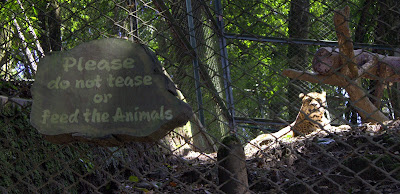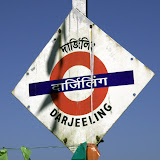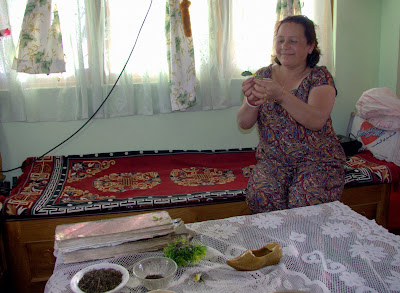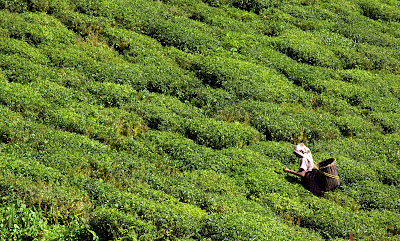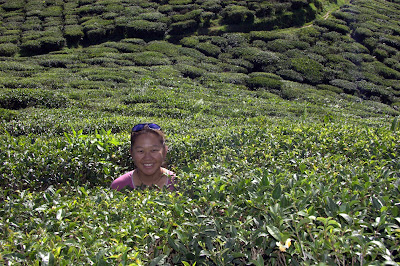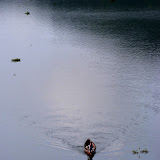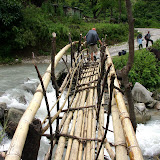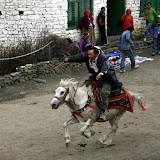Darjeeling, India - Yes, we made it to India. In the last week we've braved landslides, torrential rains, thieves, bus strikes, backwater borders, broken trains and packed jeeps. But now we have a nice room high up on a hill overlooking central Darjeeling. I'm sitting in a nice cafe sipping on a cup of milk tea and I'm ready to write about the Sun Kosi.
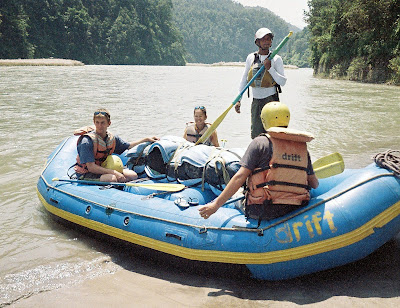
Ben, Suwei, Kamal & JB at the start of the trip.
On Tuesday the 11th we set out to raft the Sun Kosi. The name "Sun Kosi" means gold river. Some say that the name comes from the gold that can be panned from the river, others say it is from the gold or milky-brown color of the river caused by massive amounts of silt being washed down from the mountains. Gold or silt, either way, I sure had a lot of it stuck in just about every crevice of my body after 7 days on the river.
There were 11 of us on the trip, 5 tourists and six Nepalis. Of the tourists, Suwei & I, Ben (UK), & JB (France) were in the raft and Johnny (Telluride, CO) was kayaking. The Drift Nepal crew included Kamal, our raft guide, Indra, the safety kayak, Babu, pilot of the gear raft and 3 other Nepali guys who came along for training.
We entered the river near Dolalghat and traveled 170 miles (270km) east to Chatra. Normally, this would take close to 10 days, but due to high water and one hell of a fast current, we finished in a week (3 days of which were half days). Setting out we were a little worried that the high water would make the river a little too wild for our tastes and talking to the guides in Kathmandu did little to make us feel better. In the end, however, it seems the high water washed out much of the tough stuff, and although we got a lot of exciting big water we really didn't see anything above a class 4, most of the rapids being large rolling class 3's.
On day two however we got some very unexpected excitement. A landslide! Ben, just in time for the big event, had traded Johnny a seat on the raft for a bit of time in the kayak. He and the other two kayakers were about 100m in front of us when a large portion of rock came loose from the cliff above and landed in the river right next to them. They began to paddle away quickly. One of the trainees in the second safety kayak managed to flip over and was having a hard time righting himself. That's when the whole hill started to go. A section of the valley about 100ft high and maybe half that wide began to slide quickly towards the river. The gear raft now floated into range trying to warn the flipped kayaker that he needed to get out of there. Trees, rocks, mud, grass, bushes and dirt all came tumbling into the river not 20ft away from all of them. A huge wave was formed. It flipped Ben out of his kayak and onto shore. The gear raft reached the swimming kayaker and was nearly flipped by the wave too. As we approached the bend, the wave, now traveling upstream hit us head on. It was full of debris...mud, wood and leaves and must have been close to 10ft by that time. A full tsunami...it washed over the riverbank close to 60ft inland, leaving fish high and dry on the sand. We had to paddle "HARD!" (as Kamal would say) as the wave receded and tried to suck us back into the still crumbling wall. We all pulled ashore and spent the next hour or so talking about how lucky we all were and watching as the remainder of the hill continued to fall into the river one clump of rock at a time. Suwei gathered up a few of the beached fish and put them back into the water.
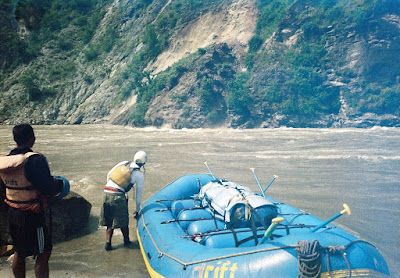 The Landslide
The Landslide
The rest of the trip paled in comparison. We had a few near flips and one of the Nepalis got bounced out on one of the rapids, but generally we spent most of the time drifting through a stunning valley full of remote villages, past overly green rice paddies and tea plantations. Kids would yell to us from the beaches, trails, shacks and bridges that lined the river. There were no roads for the entire 170 miles and it wasn't until the last day that we saw power lines and electric lights. We spent our evenings on white sand beaches, resting, reading, playing Frisbee and providing endless entertainment for the locals.
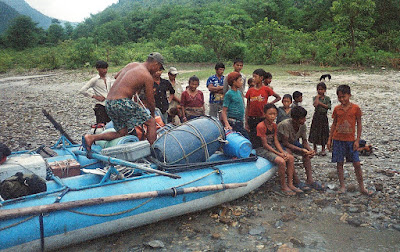 Babu Entertaining the Locals
Babu Entertaining the Locals
Our last night on the river we were joined by the crew from another raft company (Ultimate Descents Nepal, the only other crew on the river) and camped on yet another perfect beach near a village. Local kids were playing in the incredibly strong current. Johnny and JB were able replenish their kit with some local weed. We spent the afternoon reading and napping under a shelter constructed using the raft and a tarp-- first the shelter protected us from the incredibly strong sun, then torrential rains. However, it did nothing for the unbelievable humidity. We were now in the Terai region of Nepal ready to enter the wide plains of India. If we kept going we would soon be floating into Calcutta.
Johnny, JB, Ben & Suwei working hard in the Afternoon
That very night we were visited by thieves. Both Suwei and I were woken late that night by barking dogs. I got up to take a look and saw two flashlights lighting up the fog further down the beach in the Ultimate Descents Nepal camp. Not thinking much of it I returned to the stuffy, sandy dampness of our tent and went back to sleep. The next day we learned that both camps had been hit by thieves. Johnny took the hit in our camp, as he was sleeping out near his kayak but had retreated to the raft shelter when it started to rain. He had left his gear box underneath the kayak and from that box, they had taken his camera, Ipod, sunglasses, the glue and wooden dipstick from his Thermarest repair kit, and the scissors, tweezers & clippers from his medical kit. It was obvious that the thieves were not in a hurry. In the Ultimate Descents Nepal camp they actually took a dry bag that one of the guides was using as a pillow. In the bag were two cell phones, the guide's wallet with trip money, and other random gear. The event dampened an already damp morning, but Johnny and the others handled it in stride and wouldn't let it get them down too much. After all, we still had one more day on the river.
In Chatra we made a stop at a riverside temple, where one's manhood could be tested by carrying a very, very heavy rock. The rock was freakishly heavy for its size and many of the guys took turns seeing how many times they could round the temple before their arms, shoulder, back or knees gave out. I gave it a pass. After 6 months of traveling I know I'm weak. I don't need a heavy rock to prove it. One of the guides made it around 7 times.
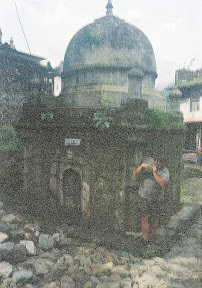 One of the Ultimate Descent Guys Rounds the Temple
One of the Ultimate Descent Guys Rounds the Temple
We had one more set of rapids before the hillsides disappeared and we were dumped into a wide delta. This is where we pulled out. We were met by a very Nepali bus (many of the windows had been replaced by plywood, you could see the tires through the floor board, and the luggage racks leaked water when it rained). It took us awhile to make it out to the main road as there was so much gear on the top of the bus that we needed a few guys up there to lift power lines when we drove through villages. Once out at the main road Suwei and I said our goodbyes. The bus was returning to Kathmandu (12-57 hours), but we were continuing east to India.
JB & Johnny
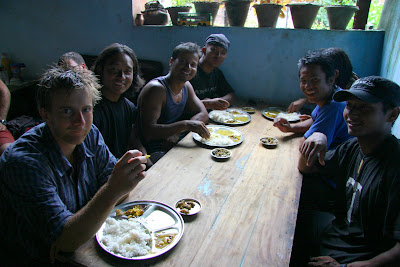
Ben & The Drift Nepal Crew
We caught a very full minibus to Itahari, where we were quickly transfered to a larger bus heading to the border town of Kakarbhitta. We were a little worried about the time as the sun was getting low, but we were assured by the driver that we would make it to the border town by 6:00pm. Well, that was until the bus stopped.
The driver and his helpers disappeared and we figured maybe they went to get some dinner. I got off the bus to find some cooler air and a little food. That's when I saw the burning tires blocking the road (never a good sign). I heard "Strike". We were 35km from Kakarbhitta and it was getting dark. We pulled the bags off the top of the bus and stashed them with us in the back seat. By this time it was dark. I got to talking to some people and they said that indeed there was a bus strike and that most likely no one was traveling anywhere this evening. They suggested finding a hotel. I searched for a hotel and found none. Then the power went out and the town was completely black. At that point we were pretty much resigned to spending the night in the back of the bus.
When the power came back on, I ventured out to see what was happening (and to get out of the stuffy bus). I met a young guy that ran a sweet shop in town. He introduced me to his cousin and his cousin's buddy and we chatted over a few cokes. There I learned that a few guys from the controlling party here in eastern Nepal were arrested 4 hours earlier. And that's when their supporters decided to block all the main roads in eastern Nepal. The road wasn't going to open until the men were released. "Maybe tonight, maybe tomorrow, maybe not," the young man told me. He offered to let us stay at his home, but we opted for staying with the bus. The police would come every 15 minutes or so, a crowd would gather, an announcement would be made, then the crowd would disperse and my friend would say, "not yet." Finally, we decided to catch some sleep. Five minutes after I laid down there was a bit of commotion outside. Our driver hopped onto the bus and started it up. Apparently, the road just opened. We made it quickly to Kakarbhitta and found a hotel just before 10pm.
After that things were a piece of cake. We wanted to get an early start as we were trying to catch the narrow gauge "toy train" departing from New Jalpaiguri to Darjeeling at 9am. The border opened at 6am and we were there at 6:05am. We were stamped out of Nepal by a guy still wearing his sleep shirt & boxers. We caught a bus packed with people and sacks of garlic in true India-style and reached Siliguri by 8:30am, where we learned that the toy train was no longer running due to landslides. After 2.5 hours in a jeep with 12 people crammed in, we finally made it here to Darjeeling. More on Darjeeling in the next entry.
No slideshow this time as the few pictures that were usable are in this post. Sorry for the quality. They were taken with a cheap disposable camera bought in Kathmandu, baked in the sun and battered with sand and silt for a week. The film was then poorly developed and even more poorly scanned at a shop here in Darjeeling. I'm surprised we had any worth using.
 Varanasi, India - We had planned to hire a row boat to take us out on the Ganges this morning, but the weather turned nasty last night and it's still wicked blowy out there right now. So, we'll take this time to tell you about our first impressions of India and our time in Darjeeling.
Varanasi, India - We had planned to hire a row boat to take us out on the Ganges this morning, but the weather turned nasty last night and it's still wicked blowy out there right now. So, we'll take this time to tell you about our first impressions of India and our time in Darjeeling.